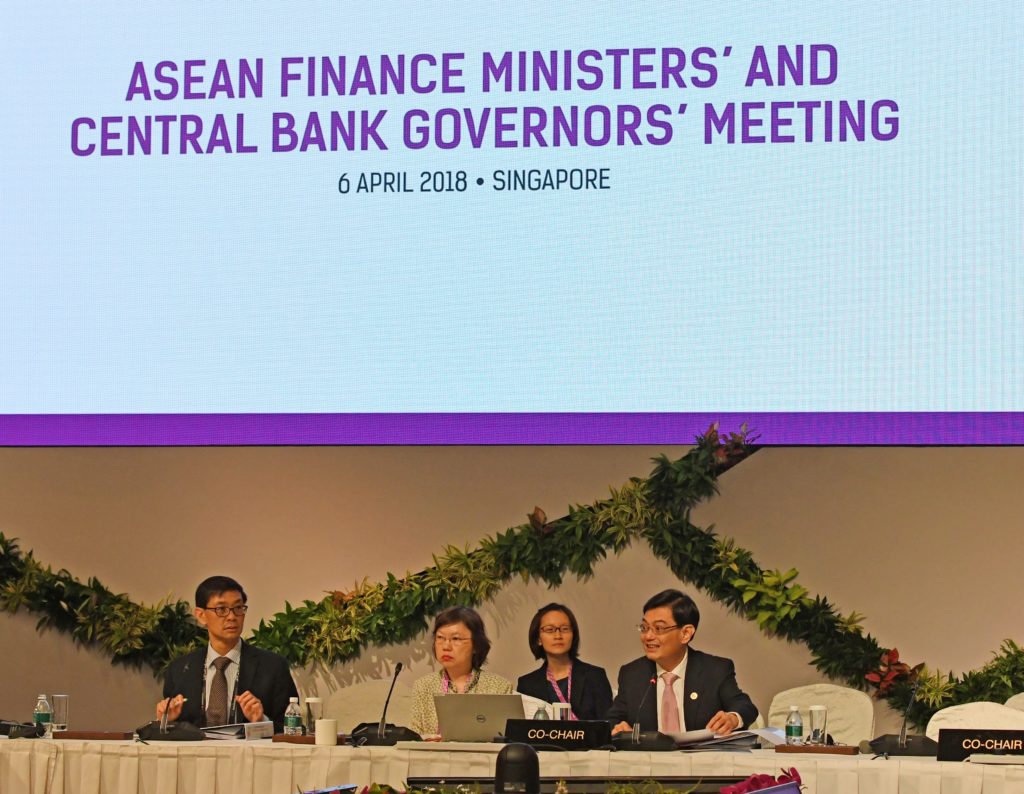Asean+3 finance, bank chiefs vow to resist protectionism

Singapore’s Finance Minister Heng Swee Keat (R) speaks during the ASEAN Finance Ministers and Central Bank Governors meeting in Singapore on April 6, 2018. / AFP FILE PHOTO
The finance ministers and central bank governors of Asean and three East Asian partner countries have vowed to push back against protectionist measures that they warned could derail world economic recovery.
“We… recognize the importance of resisting all forms of protectionism,” they said in a joint statement issued at the 21st Asean+3 Finance Ministers’ and Central Bank Governors’ Meeting in Manila.
Asean+3 refers to South-east Asia’s 10 economies, and China, Japan and South Korea.
The ministers and central bank governors reaffirmed their commitment to an “open and rules-based framework for multilateral trade and investment”.
They warned that protectionism and other risks from a faster-than-expected tightening in global financial conditions, as well as tensions arising from conflicts in places like the Korean peninsula “could induce large capital outflow and financial volatility in our region”.
Article continues after this advertisementThe statement came on the same day that the United States and China agreed to continue negotiations to avert a trade conflict.
Article continues after this advertisementThe Asean+3 Macroeconomic Research Office said on Thursday that protectionist measures which the US was lining up against China, the EU and its other major trading partners may dampen growth in Asia that is boosted by strong domestic demand, export growth and stable inflation.
Singapore’s Finance Minister Heng Swee Keat said earlier yesterday that festering trade rows, as well as new technologies and natural disasters, were among the key challenges confronting Asia as it seeks to sustain growth.
“Just as global value chains accelerate intra-regional trade and integration, they also magnify the transmission of external shocks,” he said. This becomes especially pertinent as the region faces headwinds from trade disputes.
Mr Heng added that new technologies, while offering opportunities, “also present challenges to our economies”.
Asean’s finance ministers and central bank governors have voiced concerns over attacks by hackers on the region’s financial systems.
Mr Heng said natural disasters, meanwhile, could undo years of economic gains if nothing is done to address the growing “protection gap” in financing to cover for losses due to catastrophes.
The United Nations Economic and Social Commission for Asia and the Pacific estimates that natural disasters led to over US$1 trillion in economic damage across East Asia from 1990 to 2016.
The finance ministers met yesterday to discuss setting up South-east Asia’s first “catastrophe risk pool” to narrow the “protection gap”.
The South-east Asia Disaster Risk Insurance Facility (Seadrif) is a step forward to bridging this gap, said Mr Heng. If something unfortunate happens, it will relieve the burden on governments because it can provide financing for losses to cover such an event, he added.
Seadrif taps the reinsurance industry for funding arrangements that can provide participating countries hit by natural disasters with rapid-response financing. Mr Heng said Singapore would contribute financial support to the pool, which should be in place next year.